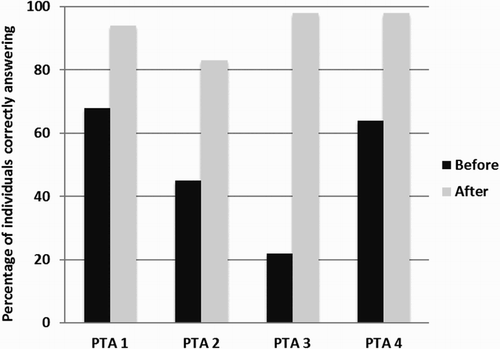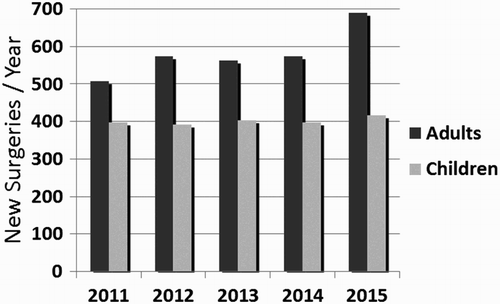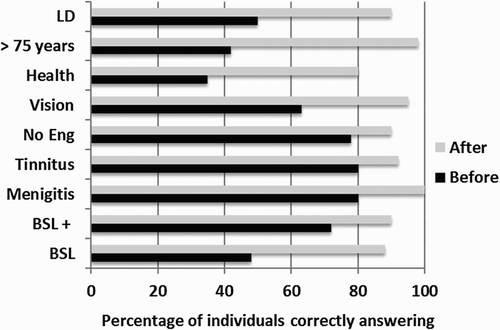Abstract
Cochlear implant (CI) intervention is expensive and accessed mainly by developed countries. The introduction of Universal Newborn Hearing Screening and funding via a public health service give children better access to CIs. However for adults large disparities exist between utilization and estimated prevalence. In the UK CI selection criteria are restrictive compared with many other countries. Improved audiological awareness and screening programmes for adults would improve access to hearing technologies that would improve health and quality of life. Hearing loss itself has significant medical and financial burdens on society and by investing in early intervention and using best technology this would mitigate some of the rising associated medical costs.
Introduction
The impact of hearing loss (HL) as a disability needs to be understood. It has a significant impact on health and society. The World Health Organization estimates that 360 million people in the world have disabling HL (5.3% of the world's population) – 91% of these are adults, the remainder are children. Approximately one-third of people over 65 years are affected, with the highest prevalence in South Asia, Asia Pacific and Sub-Saharan Africa (CitationWHO, 2012). The incidence of a congenital or early onset permanent hearing-impairment is three times higher in those areas compared with developed countries (CitationOlusanya, 2012). The cost of rehabilitation is prohibitively high in low and middle-income countries so there needs to be a primary focus on prevention (CitationOlusanya et al., 2014) and early detection followed by rapid and effective intervention which is especially important for the young, to reduce delays in language development.
Hearing aids and cochlear implants (CI's) have been shown to be cost effective in many developed countries and play a significant role in the management of children and adults with severe to profound HL.
What is happening in the UK?
Commercial multichannel CI systems have been available within the UK since the late 80s. With this duration of exposure one might be expected to regard such an intervention as ‘mature’. However, availability or access was initially restricted to charity funding until NHS support was established following an Institute of Hearing Research report showing that CI services delivered through multidisciplinary teams produced effective outcomes for both children and adults (CitationSummerfield and Marshall, 1995). The National Institute for Health and Care Excellence (NICE) performed further extensive review (CitationNICE, 2009) that has supported the clinical and cost effectiveness for CIs, resulting in more uniform access to funding. One of the main outcomes was simultaneous bilateral surgery for all children and also for adults who had additional sensory impairment.
Following the introduction of the Universal Newborn Hearing Screen (UNHS), which was gradually introduced in the UK between 2001 and 2006. It has been recognized that such screening was efficient (CitationDavis et al., 2001) and cost effective (CitationStevens et al., 1998) and has led to an improvement in the rate of identification of hearing-impairment in babies. Despite this early identification, particularly of severe to profound loss it was estimated that only about three quarters of the anticipated cases were implanted by 3 years of age. This improved to well over 90% by the time children were 9 years of age (CitationRaine, 2013). This does, however, include both congenital and progressive hearing losses.
The British Cochlear Implant Group (BCIG) collates UK data on the annual number of implantations for both children and adults. The annual rate of new children for both simultaneous and unilateral surgery is approximately 400 per year (Fig. ) and this level remains stable across years.
Understanding access for CI in adults is challenging, there has been a steady increase in the number of implantations per year, however the values are not in region predicted for the numbers of patients older than 16 years of age, with severe to profound HL reported by NICE as 613 000 (CitationNICE, 2009) in England and Wales. This figure is not at all similar to the actual numbers of implant surgeries performed in the UK (Fig. ).
Measurement of prevalence is pivotal in trying to evaluate the impact a condition might have on resources. Every 10 years the UK performs a population census. The most recent was published in 2011 (CitationOffice of National Statistics, 2011). Unlike UNHS we do not have the benefit of adult screening to identify need. CitationDavis (1995) identified the UK prevalence of HL of 35 dBHL (four-frequency average (4FA) 500, 1000, 2000 and 4000 Hz) or more in the better ear as being approximately one in 12 of the population. More specifically he reported that in the 18–80-year-olds 0.7% had a severe HL (70–94 dB HL) and 0.2% a profound HL (>95 dB HL) (CitationDavis, 1995). CitationAkeroyd et al. (2014) using the national study data and estimated numbers of cases in England and Wales and stated that it should be 3.49 million adults aged between18 and 80. [95% confidence intervals 2.8–5.3 million]. What the National Study did not measure was the audiological information of those older than 80 years. However, CitationDavis (1995) did give estimates of 81% for those 80+ years who would have a HL of at least 35 dBHL 4FA. In England and Wales this equates to about 1.45 million individuals. Current NICE audiological guidelines for CI are ≥90 dB HL at 2 and 4 kHz. Based on the principles previously reported (CitationRaine, 2013) the census gives a potential annual prevalence of 11 800 in the 18–80 year cohort and nearly 5000 for >80 years. Data for surgical registration for >80 years in 2011 was a meagre 26 (CitationRaine, 2013).
There are multiple factors in establishing the extent to which adults with profound HL would present for CI assessment and, subject to satisfactory evaluation, proceed to implantation, some of which may be;
Acceptance of deterioration of capacity with age.
Presence of a partner who supports and ameliorates overall effect of such HL.
Lack of awareness.
Failure of primary care to propose CI treatment.
Failure of audiology units to propose CI treatment.
Poor health and reluctance to undergo surgery.
It is logical to assume that the main ‘gatekeeper’ should be the audiologist, as at some stage patients would require hearing tests, and a hearing aid trial. We therefore need to understand if audiologists are aware of referral criteria? The goal of this work was to determine the level of awareness of implant candidacy in traditional referring audiologists and to determine if education leads to an improvement in knowledge.
Methods
An audit of knowledge on referral scenarios was devised and after an initial pilot was submitted via an online survey to audiologists within the Yorkshire region. Based on current NICE auditory guidance's of ≥90 dBHL at 2 and 4 kHz, four pure tone audiograms demonstrating a variety of hearing losses were produced. Similarly, nine clinical statements were devised. The responses would be ‘yes’, ‘no’ or ‘not sure’ for being within candidacy.
Audiological scenarios
Single sided deafness with loss at 2 and 4 kHz ≥ 90 dBHL in the affected ear. Not within candidacy criteria.
Asymmetric SNHL with responses 75 and 80 dB in the better ear; ≥90 dB in the worst hearing ear at 2 and 4 kHz. Not within candidacy criteria.
Ski slope symmetrical SNHL – good preservation at low frequencies with responses ≥100 dB HL at 2 and 4 kHz. Within candidacy criteria.
Slight asymmetric SNHL with responses ≥95 dB HL and ≥110 dB HL at 2 and 4 kHz respectively. Within candidacy criteria.
Clinical scenarios
The following statements were presented for a response of suitability of referral. All cases have a bilateral severe/profound HL unless otherwise stated. The abbreviations are used as the legends in (Fig. )
British Sign Language Users who do not use spoken language (BSL).
Deaf people who use British Sign Language and speech (BSL +).
People who have lost their hearing through meningitis (Meningitis).
People with mild to moderate HL suffering greatly from tinnitus (Tinnitus).
Deaf adults who have no spoken English but who use another spoken language (No Eng).
Adults with moderate HL with significant visual problems (Vision).
Deafened adults who have other significant health problems (Health).
Deafened adults aged over 75 years (>75).
Deafened adults with learning difficulties (LD).
Following initial analysis, the audiologists were invited to seminars on CI management, discussing various aspects of patient selection and outcomes related to patient specific needs. Shortly after the training the survey was re-circulated to determine if responses had changed.
Results
Fifty three audiologists participated in the surveys and seminars. The improvement in knowledge following training is clearly demonstrated (Fig. ). The chart indicates the percentage of individuals with the correct understanding of candidacy criteria before and after training for four audiometric profiles.
Figure 2 Percentage of individuals correctly responding with respect to candidacy criteria for four pure tone audiological scenarios before and after training

With regard to responses to clinical scenarios (nine statements), (Fig. ) highlights the percentage of individuals correctly responding before and after the training seminars as to the candidacy appropriateness.
Discussion
This audit and training intervention was completed in 2013. Audiograms 3 and 4 illustrated hearing losses falling within CI candidacy (Fig. ). However, only 24 and 68% of audiologists for audiograms 3 and 4, respectively, would have referred these patients. This improved to 98% following training. Similarly, it is interesting to reflect that hearing problems, mode of communication, age, health issues, learning difficulties and additional sensory impairment influenced and restricted referrals (Fig. ).
What the Yorkshire Auditory Implant Service (YAIS) subsequently has noted was a significant threefold increase in adult referrals. Analysis of outcomes for 2013–2014 showed that whilst 95 adults fitted the audiological criteria. Forty six were not suitable, as their BKB sentences scores were better than 50%. Clinically, the view of the clinical team was that many of the individuals who were turned down would have benefited from CI when other, performance measures were performed. Of the remainder, 14 declined surgery and 35 proceeded to surgery.
Global access to CI is diverse (CitationSorkin, 2013a). CI is primarily found in developed countries because of the costs of the intervention and maintenance. Utilization in the USA is variable with about 50% of children and less than 5% of estimated adults (CitationSorkin, 2013b) having CI's, with an overall penetration of about 6%. Japan offers universal healthcare yet current uptake is approximately 1% of all subjects (CitationOliver, 2013). China started implementation of UNHS in 1999. Governmental funding has been agreed which will lead to improve access for children with anticipated significant growth over the next few years (CitationLiang and Mason, 2013). Variations are noted related to mode of health care provision and parental barriers (CitationArmstrong et al., 2013).
In all countries the true prevalence of severe to profound HL in adults can only be an estimate. It has been demonstrated that utilization of CI's, especially in adults, appears to be extremely low. It is reported that HL has a greater impact on social and educational aspects of life rather than health services (CitationBubbico et al., 2007) and the ultimate cost of HL is huge. Studies in the USA estimate the cost to be 2.5–3% of Global National Product (CitationRuben, 2000). The medical affects to the patient are often manifested in mental illness and dementia (CitationLin et al., 2011) and premature death (CitationContrera et al., 2015; CitationFriberg et al., 2014) amongst many other issues reported by CitationLamb et al. (2015). People with mild HL are twice as likely to develop dementia as people without HL; the risk increases fivefold for people with severe HL (CitationLin et al., 2013). Mosnier et al. have recently shown in their national study that elderly patients showed improvements in speech perception and cognitive abilities with positive influences on their social activity and quality of life (CitationMosnier et al., 2015). Providers of health care need to carefully evaluate these implications.
Within the UK the anticipated adult utilization is below 5%. With the increase in referrals to the YAIS CI unit as a result of CI auditory awareness training, it would be anticipated to have a noticeable improvement if this were rolled out nationally. The uptake for children is nearly 95%. It is felt that UNHS plays a major role in screening potential patients. However, only three quarters are implanted by 3 years of age. The figures do not distinguish between congenital and those with progressive losses. CitationDe Raeve and Wouters (2013), reported that in Flanders, with UNHS, CI assessment and when appropriate children receive their implant before their first birthday. Funding for bilateral CI was established for those under 12 in 2010 (CitationDe Raeve and Wouters, 2013).
The UK performs half the number per million of population as compared with Germany or Austria (Citationvan Hardeveld, 2010). It would appear that they take a more pragmatic approach and assess the individual patient needs using their own set of guidelines published on behalf of the German Society for Oto-Rhino-Laryngology, head and Neck Surgery (CitationADANO, 2012).
It is time to reflect. Prevention of disease should be paramount. However, understanding prevalence of a disease is important in order to manage it. UNHS and public health care systems give children better access to CI. Vigilance is still required to detect and monitor those children who have progressive HL.
Have we taken for granted that even after 25 years of CI in the UK all audiologists understand the indications and significance of CI? Hogan and colleagues back in 2001 recognized the needs of ‘fostering relationships within the broader audiological community’ (CitationHogan et al., 2001). To address the ‘need’ there should be a drive to have a systematic hearing screen of older adults. Health care policy needs to be inclusive and reflective. Access to hearing devices and especially CIs will improve health and wellbeing.
Disclaimer statements
Contributors None.
Funding None.
Conflict of interest None.
Ethics approval None.
References
- ADANO. 2012. " Cochlea-Implantat Versorgung und zentral-auditorische Implantate http://www.acir.de/ADANO_ci_leitlinie.pdf."
- Akeroyd, M.A., Foreman, K., Holman, J.A. 2014. Estimates of the number of adults in England, Wales, and Scotland with a hearing loss. International Journal of Audiology, 53(1): 60–61. doi: 10.3109/14992027.2013.850539
- Armstrong, M., Maresh, A., Buxton, C., Craun, P., Wowroski, L., Reilly, B., et al. 2013. Barriers to early pediatric cochlear implantation. International Journal of Pediatric Otorhinolaryngology, 77(11): 1869–1872. doi: 10.1016/j.ijporl.2013.08.031
- Bubbico, L., Bartolucci, M.A., Broglio, D., Boner, A. 2007. Societal cost of pre-lingual deafness. Ann Ig, 19(2): 143–152.
- Contrera, K.J., Betz, J., Genther, D.J., Lin, F.R. 2015. Association of hearing impairment and mortality in the national health and nutrition examination survey. JAMA Otolaryngology – Head & Neck Surgery, 1–3. doi: 10.1001/jamaoto.2015.1762
- Davis, A. 1995. Hearing in adults. The prevalence and distribution of hearing impairment and reported hearing disability in the MRC Institute of Hearing Research's National Study of Hearing. Whurr.
- Davis, A., Bamford, J., Stevens, J. 2001. Performance of neonatal and infant hearing screens: sensitivity and specificity. British Journal of Audiology, 35(1): 3–15.
- De Raeve, L., Wouters, A. 2013. Accessibility to cochlear implants in Belgium: state of the art on selection, reimbursement, habilitation, and outcomes in children and adults. Cochlear Implants International, 14(Suppl. 1): S18–S25. doi: 10.1179/1467010013Z.00000000078
- Friberg, E., Rosenhall, U., Alexanderson, K. 2014. Sickness absence and disability pension due to otoaudiological diagnoses: risk of premature death – a nationwide prospective cohort study. BMC Public Health, 14:137–144. doi: 10.1186/1471-2458-14-137
- van Hardeveld, R. 2010. Special bulletin – May 2010. Results enquiry 2009. EURO-CIU.
- Hogan, A., Taylor, A., Westcott, S. 2001. Audiologists’ attitudes to cochlear implants. Cochlear Implants International. 2(1): 17–29. doi: 10.1179/cim.2001.2.1.17
- Lamb, B.A., Archbold, S., O'Neill, C. 2015. Bending the Spend: expanding access to hearing technology to improve health, wellbeing and save public money. The Ear Foundation. www.earfoundation.org.uk/files/download/1077
- Liang, Q., Mason, B. 2013. Enter the dragon–China's journey to the hearing world. Cochlear Implants International, 14(Suppl. 1): S26–S31. doi: 10.1179/1467010013Z.00000000080
- Lin, F.R., Metter, E.J., O'Brien, R.J.S., Resnick, M., Zonderman, A.B., Ferrucci, L. 2011. Hearing loss and incident dementia. Archives of Neurology, 68(2): 214–220. doi: 10.1001/archneurol.2010.362
- Lin, F.R., Yaffe, K., Xia, J., Xue, Q.L., Harris, T.B., Purchase-Helzner, E., et al. 2013. Hearing loss and cognitive decline in older adults. JAMA Internal Medicine 173(4): 293–299. doi: 10.1001/jamainternmed.2013.1868
- Mosnier, I., Bebear, J.P., Marx, M., Fraysse, B., Truy, E., Lina-Granade, G., et al. 2015. Improvement of cognitive function after cochlear implantation in elderly patients. JAMA Otolaryngology – Head & Neck Surgery, 141(5): 442–450. doi: 10.1001/jamaoto.2015.129
- National Institute for Health and Care Excellence Technology Appraisal Guidance 2009. Cochlear implants for children and adults with severe to profound deafness. NICE technology appraisal guidance [TAG166]. [Accessed 2016, January 29]. Available from http://www.nice.org.uk/ta166.
- Office of National Statistics 2011. National Population Projections 2010-based Statistical Bulletin. Available from http://www.ons.gov.uk/ons/dcp171778_235886.pdf.
- Oliver, J. 2013. New expectations: pediatric cochlear implantation in Japan. Cochlear Implants International, 14(Suppl. 1): S13–S17. doi: 10.1179/1467010013Z.00000000079
- Olusanya, B.O. 2012. Neonatal hearing screening and intervention in resource-limited settings: an overview. Archives of Disease in Childhood, 97(7): 654–659. doi: 10.1136/archdischild-2012-301786
- Olusanya, B.O., Neumann, K.J., Saunders, J.E. 2014. The global burden of disabling hearing impairment: a call to action. Bulletin of the World Health Organization, 92(5): 367–373. doi: 10.2471/BLT.13.128728
- Raine, C. 2013. Cochlear implants in the United Kingdom: awareness and utilization. Cochlear Implants International, 14(Suppl. 1): S32–S37. doi: 10.1179/1467010013Z.00000000077
- Ruben, R.J. 2000. Redefining the survival of the fittest: communication disorders in the 21st century. Laryngoscope, 110(2 Pt 1): 241–245. doi: 10.1097/00005537-200002010-00010
- Sorkin, D.L. 2013a. Access to cochlear implantation. Cochlear Implants International, 14(Suppl. 1): S1. doi: 10.1179/1467010013Z.00000000081
- Sorkin, D.L. 2013b. Cochlear implantation in the world's largest medical device market: utilization and awareness of cochlear implants in the United States. Cochlear Implants International, 14(Suppl. 1): S4–S7.
- Stevens, J.C., Hall, D.M., Davis, A., Davies, C.M., Dixon, S. 1998. The costs of early hearing screening in England and Wales. Archives of Disease in Childhood, 78(1): 14–19. doi: 10.1136/adc.78.1.14
- Summerfield, A.Q., Marshall, D.H. 1995. Cochlear implantation in the UK 1990 – 1994. HMSO.
- WHO, W.H.O. 2012. WHO global estimates on prevalence of hearing loss. [Internet]. Geneva: World Health Organization. [Accessed 2015, December 26]. http://www.who.int/pbd/deafness/estimates.


